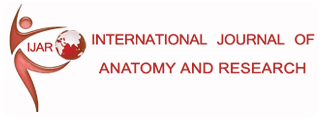IJAR.2024.251
Type of Article: Original Research
Volume 13; Issue 1 (March 2025)
Page No.: 9145-9156
DOI: https://dx.doi.org/10.16965/ijar.2024.251
Morphometric Analysis of Major Sulci of The Cerebral Hemisphere and Their Variations: A Cadaveric and Radiological Study
Sudarshana Smita.
Assistant Professor, Department of Anatomy, ESIC Medical College, Bihta, Patna, Bihar, India.
ORCiD: https://orcid.org/0009-0009-6785-6456
Correspondence Author: Dr Smita Sudarshana, Assistant Professor, Department of Anatomy, ESIC Medical College, Bihta, Patna, Bihar, 801103, India. E-Mail: smitasudarshana1973@gmail.com
ABSTRACT:
Background: Sulci are extensions of the subarachnoid space. Accurate knowledge of the brain’s sulci is important for neurosurgeons for many reasons: (a) sulci can be used as landmarks for cortical mapping, that is; to identify specific functional areas of the brain, (b) localize the craniotomy procedure, (c) can be used as micro-neurological corridors to access deep areas of the brain. Besides, knowledge of sulci can help reduce the risk of functional deficit after surgery and understand neuroimaging, which is crucial for image-guided procedures. Thus, knowledge of sulci and their variations helps neurosurgeons perform brain surgery safely and effectively.
Objective: To locate and measure the extent of the major sulci of the cerebral hemisphere by using various anatomical landmarks in a cadaveric brain specimen and images of computed tomographic scans of the brain, and to observe their variations.
Material and Methods: The study design was a descriptive cross-sectional survey. Twenty cerebral hemispheres (10 right and 10 left) of cadaveric brain specimens, well preserved in formalin, and one hundred randomly selected computed tomographic scans of the brains were examined meticulously. A total of 19 parameters (eight in cadaveric and eleven in radiological study) were assessed for measurement of sulci and its neighboring areas. The measurements of the various parameters were done using vernier calipers, thread, scale, and beaded pins. An Independent t-test was done to compare the means of the measurements of the parameters between the left and right-sided cerebral hemispheres; p-values were calculated to find if the results were significantly different in the left and right cerebral hemispheres. Variations of the major sulci were also observed.
Results: In the cadaveric study, no significant differences between the parameters of the right and the left hemispheres were observed, except for the posterior part of the calcarine sulcus (p-value=0.0248). On the other hand, significant differences were observed in many parameters of the left and right cerebral hemispheres in a radiographic study (p-value- <0.05). Variations were noted in 15 percent (3/20) of the cerebral hemisphere in cadaveric samples.
Conclusion: The study provides further insights into identifying the important functional area of the brain located near the sulci and their variations which may aid neurosurgeons in planning and executing their surgery safely and effectively
Key words: Central sulcus, Lateral sulcus, PO sulcus, Calcarine sulcus.
REFERENCES
[1]. Standring S., editor. Gray’s Anatomy e-book: The Anatomical Basis of Clinical Practice. Elsevier Health Sciences; 2021. p. 373. (Chapter 25 cerebral hemisphere).13-1237-7.
[2]. Gonul Y., Songur A., Uzun I., Uygur R., Alkoc O.A., Caglar V., Kucuker H. Morphometry, asymmetry and variations of cerebral sulci on superolateral surface of the cerebrum in autopsy cases. Surg Radiol Anat. 2014;36(7):651-661.
https://doi.org/10.1007/s00276-013-1237-7
PMid:24258359
[3]. Ribas G.C., Ribas E.C., Rodrigues C.J. The anterior sylvian point and the suprasylvian operculum. Neurosurg Focus. 2005;18(6):1-6.
https://doi.org/10.3171/foc.2005.18.6.15
[4]. Yasargil M.G., Krisht A.F., Türe U., Al-Mefty O., Yasargil D.C. Microsurgery of insular gliomas: part I-surgical anatomy of the sylvian cistern. Contemp Neurosurg. 2017;39(11):1-8.
https://doi.org/10.1097/01.CNE.0000527943.73058.68
[5]. Mc Minn R.M.H., editor. Last’s anatomy regional and applied. 9th ed. Vol. 151. Churchill Livingstone; London: 1994. Central nervous system; pp. 579-591.
[6]. Nayak S, Gupta C, Hebbar KD, Pandey AK. Morphometric analysis of the main brain sulci and clinical implications: Radiological and cadaveric study. J Taibah Univ Med Sci. 2023 Jan 17;18(4):676-686.
https://doi.org/10.1016/j.jtumed.2023.01.004
PMid:36852242 PMCid:PMC9957773
[7]. Ono M., Kubik S., Abernathey C.D. Thieme Medical Publishers; New York: 1990. Atlas of the cerebral sulci. G. Thieme Verlag.
[8]. Singh P.K., Gupta R. Morphometry of the central sulcus in the brain of Uttar Pradesh region. Int J Sci Stud. 2015;3(5):1-4.
[9]. Flores L.P. Occipital lobe morphological anatomy: anatomical and surgical aspects. Arq Neuropsiquiatr. 2002;60:566-571.
https://doi.org/10.1590/S0004-282X2002000400010
PMid:12244393
[10]. Mandal L., Mandal S.K., Dutta S., Ghosh S., Singh R., Chakraborty S.S. Variation of the major sulci of the occipital lobe – a morphological study. Al Ameen J Med Sci. 2014;7(2):141-145.
[11]. Ebeling U, Steinmetz H. Anatomy of the parietal lobe: Mapping the individual pattern. Acta Neurochirurgica. 1995;136(1-2):8-11.
https://doi.org/10.1007/BF01411428
PMid:8748820
[12]. Chi JG, Dooling EC, Gilles FH. Gyral development of the human brain. Ann Neurol. 1977;1(1):86-93
https://doi.org/10.1002/ana.410010109
PMid:560818
[13]. Retzius G., Andersson S. Königlich Buchdruckerei; 1896. Das Menschenhirn: Studien in der makroskopischen Morphologie. Available form: https://ruomoplus.lib.uom.gr/bitstream/8000/270/1/Retzius_NEUS_2016_final_ms.pdf
[14]. Malikovic, A., Vucetic, B., Milisavljevic, M. et al. Occipital sulci of the human brain: variability and morphometry. Anat Sci Int. 2012; 87:61-70. https://doi.org/10.1007/s12565-011-0118-6
PMid:21993979
[15]. Dharmendra Kumar, Manisha B Sinha, Madhusmita Panda, Chinmayi Mohapatra. Revisiting almost forgotten two ends of the central sulcus of cerebral hemisphere in brains of cadavers. Indian Journal of Clinical Anatomy and Physiology 2020 ;7(3):304-308.
https://doi.org/10.18231/j.ijcap.2020.062
[16]. Corballis, M. C. The evolution and genetics of cerebral asymmetry. Philos. Trans. R. Soc. Lond. B Biol. Sci. 2009;364:867-879.
https://doi.org/10.1098/rstb.2008.0232
PMid:19064358 PMCid:PMC2666079
[17]. Vogel J. J., Bowers C. A., Vogel D. S. Cerebral lateralization of spatial abilities: a meta-analysis. Brain and Cognition. 2003;52(2):197-204.
https://doi.org/10.1016/S0278-2626(03)00056-3
PMid:12821102
[18]. Bethmann, A., Tempelmann, C., De Bleser, R., Scheich, H., and Brechmann, A. Determining language laterality by fMRI and dichotic listening. Brain Res. 2007;1133: 145-157.
https://doi.org/10.1016/j.brainres.2006.11.057
PMid:17182011
[19]. Ocklenburg, S., Güntürkün, O., and Beste, C. Lateralized neural mechanisms underlying the modulation of response inhibition processes. Neuroimage 2011a;55:1771-1778.
https://doi.org/10.1016/j.neuroimage.2011.01.035
PMid:21256235
[20]. Vallortigara G, Rogers LJ, Bisazza A. Possible evolutionary origins of cognitive brain lateralization. Brain Res Brain Res Rev. 1999 Aug;30(2):164-75.
https://doi.org/10.1016/S0165-0173(99)00012-0
PMid:10525173








